The topic of this article may not meet Wikipedia's notability guideline for stand-alone lists .(January 2023) |
Railway stations in Oman include
The topic of this article may not meet Wikipedia's notability guideline for stand-alone lists .(January 2023) |
Railway stations in Oman include
( all 1,435 mm (4 ft 8+1⁄2 in) gauge) [1]
This article is about transport in Oman.

The United Arab Emirates is situated in the Middle East and southwest Asia, bordering the Gulf of Oman and the Persian Gulf, between Oman and Saudi Arabia; it is at a strategic location along the northern approaches to the Strait of Hormuz, a vital transit point for world crude oil. The UAE lies between 22°50′ and 26° north latitude and between 51° and 56°25′ east longitude. It shares a 19 km (12 mi) border with Qatar on the northwest, a 530 km (330 mi) border with Saudi Arabia on the west, south, and southeast, and a 450 km (280 mi) border with Oman on the southeast and northeast.

Al Ain is a city on the eastern side of Tawam oasis and the seat of the administrative division of its namesake, Al Ain in the Emirate of Abu Dhabi, United Arab Emirates. It is bordered to the east by the Omani town of Al-Buraimi in the Al Buraimi Governorate. It is the largest inland city in the Emirates, the fourth-largest city, and the second-largest in the Emirate of Abu Dhabi. The freeways connecting Al-Ain, Abu Dhabi, and Dubai form a geographic triangle in the country, each city being roughly 130 kilometres (81 mi) from the other two.

Nizwa is the largest city in Ad Dakhiliyah Region in Oman and was the capital of Oman proper. Nizwa is about 140 km (87 mi) from Muscat. The population is estimated at around 72,000 people, including the two areas of Burkat Al Mooz and Al-Jabel Al-Akhdar.
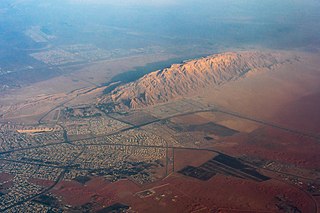
Jabal Hafeet is a mountain in the region of Tawam, on the border of the United Arab Emirates and Oman, which may be considered an outlier of Al Hajar Mountains in Eastern Arabia. Due to its proximity to the main Hajar range, the mountain may be considered as being part of the Hajar range. To the north is the UAE city of Al Ain, in the Eastern Region of the Emirate of Abu Dhabi, and the adjacent Omani town of Al-Buraimi.
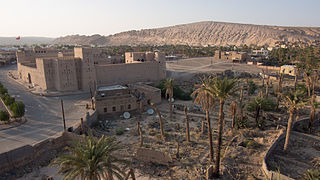
Ibri is a city and Wilāyat (Province) in the Ad Dhahirah Governorate, in northwest Oman.

The Arabian tahr is a species of tahr native to eastern Arabia. Until recently, it was placed in the genus Hemitragus, but genetic evidence supports its removal to a separate monotypic genus, Arabitragus.
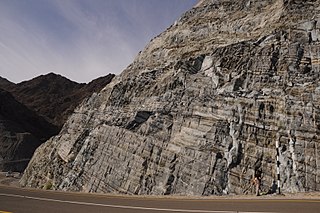
The geology of Oman includes varied landscapes which are a blend of its geological history, and its climate over the past few million years. Rock outcrops in Al Hajar Mountains, the Huqf and Dhofar are a point of interest for international geologists. The rock record spans about 825 million years and includes at least three periods when the country was covered by ice.
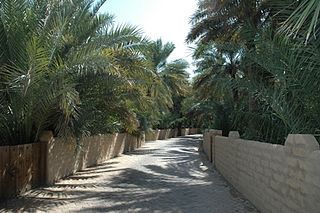
Al-Ain Oasis is the largest oasis in the city of Al Ain, within the Eastern Region of the Emirate of Abu Dhabi, the United Arab Emirates.

The Hajar Mountains in northeastern Oman and also the eastern United Arab Emirates are the highest mountain range in the eastern Arabian peninsula. Also known as "Oman Mountains", they separate the low coastal plain of Oman from the high desert plateau, and lie 50–100 km (31–62 mi) inland from the Gulf of Oman.
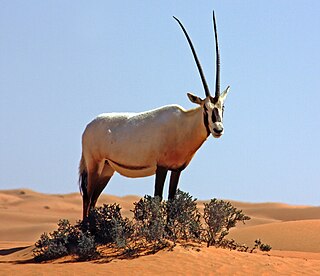
The wildlife of the United Arab Emirates is the flora and fauna of the country on the eastern side of the Arabian Peninsula and the southern end of the Persian Gulf. The country offers a variety of habitats for wildlife including the coast, offshore islands, mangrove areas, mudflats, salt pans, sand and gravel plains, sand dunes, mountain slopes, wadis and rocky summits. Because the terrain is so varied, it supports a greater number of species of plants and animals than might have been expected in this relatively small country.

The wildlife of Oman is the flora and fauna of this country in the southeastern corner of the Arabian Peninsula, with coasts on the Gulf of Oman and the Arabian Sea. The climate is hot and dry, apart from the southeastern coast, and the country offers a variety of habitats for wildlife including mountains, valleys, deserts, coastal plains and sea coasts.
Oman Rail is a railway company responsible for rail transport in Oman. It is owned and operated by the Omani Ministry of Transport. The company is based in Al Qurum, Muscat.
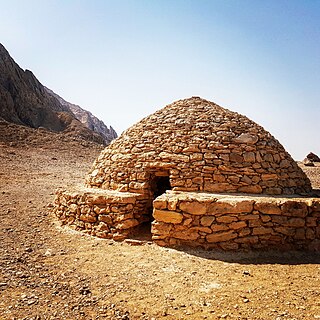
The Hafit period defines early Bronze Age human settlement in the United Arab Emirates and Oman in the period from 3200 to 2600 BC. It is named after the distinctive beehive burials first found on Jebel Hafit, a rocky mountain near Al Ain, bordering the Rub Al Khali desert. Hafit period tombs and remains have also been located across the UAE and Oman in sites such as Bidaa bint Saud, Jebel Al-Buhais and Buraimi.

The Eastern Region is one of three Municipal Regions in the Emirate of Abu Dhabi. It forms the southeastern part of the United Arab Emirates. Its main settlement is the city of Al Ain, located on the country's border with Oman, about 160 km (99 mi) from the city of Abu Dhabi, the capital of the Emirate and country. Compared to the Western Region, it is also a rather remote region of the Emirate, but smaller by area, and is not known to hold reserves of gas or petroleum, but is agriculturally important.
The geology of the United Arab Emirates includes very thick Paleozoic, Mesozoic and Cenozoic marine and continental sedimentary rocks overlying deeply buried Precambrian. The region has extensive oil and gas resources and was deformed during the last several million years by more distant tectonic events.

Tawam, also Tuwwam, Tu'am, or "Al-Buraimi Oasis", is a historical oasis region in Eastern Arabia that stretched from, or was located between, the Western Hajar Mountains to the Persian Gulf coast, nowadays forming parts of what is now the United Arab Emirates and western Oman. It is marked by the twin settlements of Al Ain and Al-Buraimi on the UAE-Omani border.

Mezyad is a settlement in Al-Ain Region in the Emirate of Abu Dhabi, the United Arab Emirates, located to the south of the main part of Al Ain City, on the border with Oman. It is known for having a historical fort, and is part of a desert park, which also includes a necropolis and Mount Hafeet nearby. The park can be called either "Mezyad Desert Park" or "Jebel Hafeet Desert Park".

The Oman–United Arab Emirates border consists of three non-contiguous sections totalling 609 km in length.